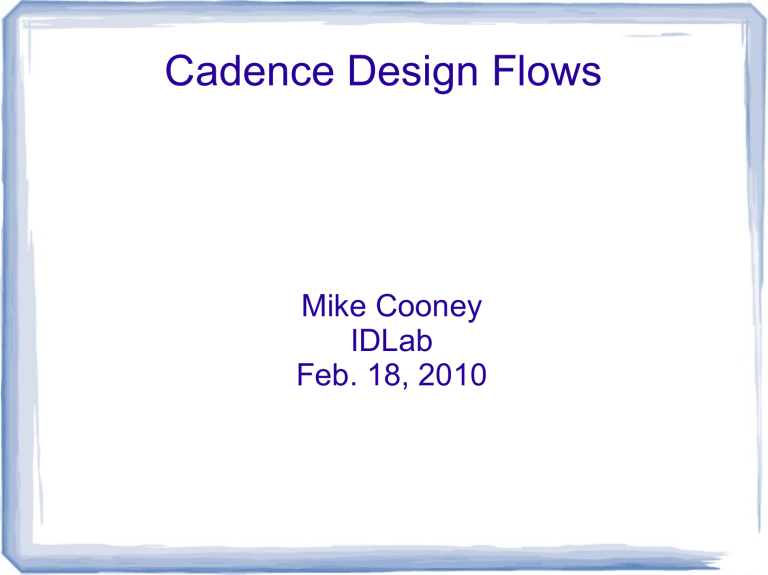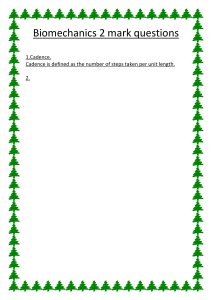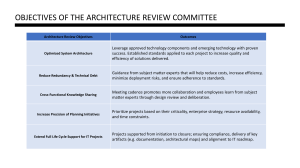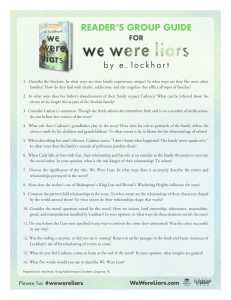
Cadence Design Flows Mike Cooney IDLab Feb. 18, 2010 Outline ● Cadence Design Flows ● Cadence Tools ● Simulations ● Design Checks ● Design Kit Info 2 Cadence Design Flows ● ● ● ● A design flow is from initial design conception to tape-out. Design flows are broken into three types: – Digital – Analog – Mixed – Signal Choose a flow based on what the majority of your design will use. In FPGA terms, the design flow is broken into three stages (with Xilinx) and all integrated together. ASIC tools are much more separated. 3 Digital Flow ● ● ● Design using an HDL The synthesizer does (most) placement and optimization of the design Designer might never even see the layout – ● How FPGA flow works Requires standard cells supported by the tool – Flip-flops, inv, pads, etc 4 Analog Flow ● ● ● Schematic based design flow and simulation Manual placement and drawing of all structures* Works with libraries from other tools * Options for auto-placement and auto-routing. 5 Mixed Signal Flow ● ● Having both digital (HDL) and analog designed components in a single design Can be primarily digital or analog focused – Can mix and match for a design 6 Cadence Tools ● ● Versions: – Cadence 5 vs Cadence 6 – L, XL, GXL Digital: – ● Analog: – ● SOC Encounter Virtuoso, Schematic Simulations: – ADE 7 Cadence Versions ● ● Cadence 5: – More design kit support – More PCELL / SKILL* support – CDB backend – Support phasing out in 1-2 years Cadence 6: – Completely different design kit requirements – Long term / future support – OA (Open Access) backend PCELL: Automatically adjusted cells, e.g. transistors in the IBM kit SKILL: Cadence scripting environment / language 8 Backend information ● CDB is the storage format for Cadence 5. ● OA is the storage format for Cadence 6. ● CDB and OA are NOT compatible! ● Conversion is supported. Kind of. ● ● If you have a design library from Cadence 5, you must convert the design to OA to use in Cadence 6. CDB → OA is possible. OA → CDB not so much. 9 Version Letters ● ● Cadence has three levels of products (applies to Virtuoso Schematic and Layout): – L – Basic tools, polygon editor (V) – XL – Interconnection information (V) – GXL – Automatic tools: placement, routing, etc. Cadence uses 'tokens' for licensing: – L might use 1 token, XL 3 tokens, GXL 9 tokens. – Stick with XL when possible. – NOTE: If you open a design with L in layout and save, you lose the interconnection information. Therefore, if you open later with XL, you won't see connection information. 10 SOC Encounter ● Cadence's digital RTL – GDSII program ● Supports HDL* while performing`: – Floorplanning – Clock distribution – Power planning – Place and Route (PR) – Analysis ● Timing, Power, Interconnect, Signal integrity, etc – Design for Manufacturing (DFM) – Design Rule Checking (DRC) * HDL = Verilog, VHDL, Verilog-a, VHDL-a, System-C, etc ` Technically they are separate tools integrated into SOC. 11 Virtuoso ● Cadence's analog design tools ● Includes: ● – Schematic – Layout Integrates analog layouts with block placements 12 Analog Design Environment (ADE) ● ADE is a visual wrapper to command line simulation environment (Spectre) ● Integrated results browser (wavebrowse) ● Performs many simulation types: – Trans, DC, parametric, etc 13 Spectre ● Spectre is Cadence's version of SPICE. ● Spectre is ~compatible with SPICE. – ● We use Spectre 7.0 – ● For proper models (IBM), both Spectre and SPICE will converge. Default Spectre included with Virtuoso is 5.1, does not work with IBM models. Spectre models are different than SPICE models! – There is a tool (spp) to convert SPICE to Spectre models. It is touchy to say the least. 14 Some things to keep in mind ● ● You must place a vdc=1.2 somewhere in your schematic for simulations Simulations are only as good as the data you input – ● Simulations don't check manufacturability Design kits get upgraded – Don't save libraries/simulations/etc inside the design kit directory! 15 Folder Hierarchy ● /$USER – /design ● ● /library – /$PROJECT_NAME – /IBM_1.6.2.5_IC614 ● /DRC ● /LVS /kits 16 17 18




